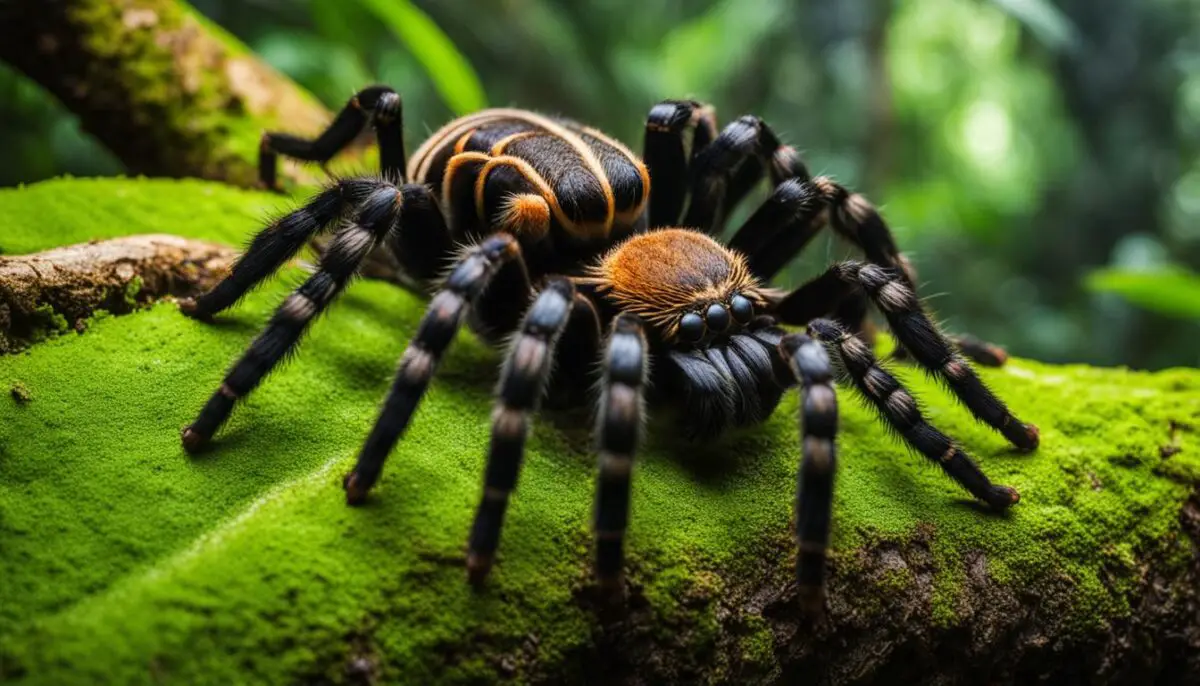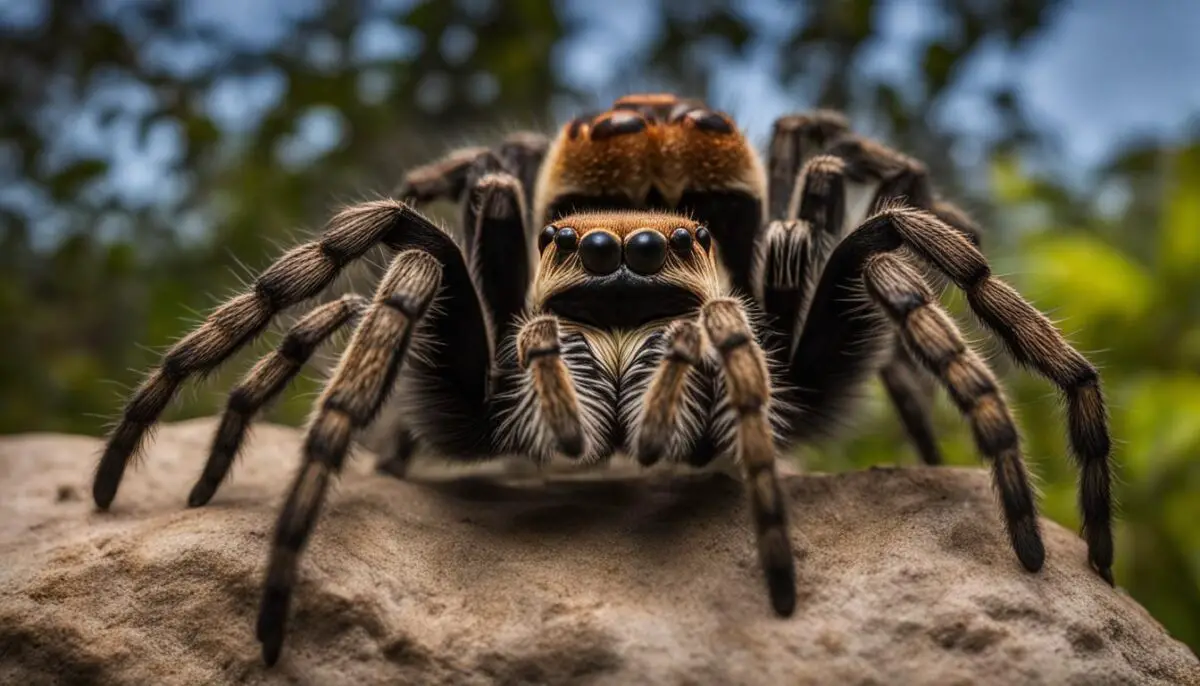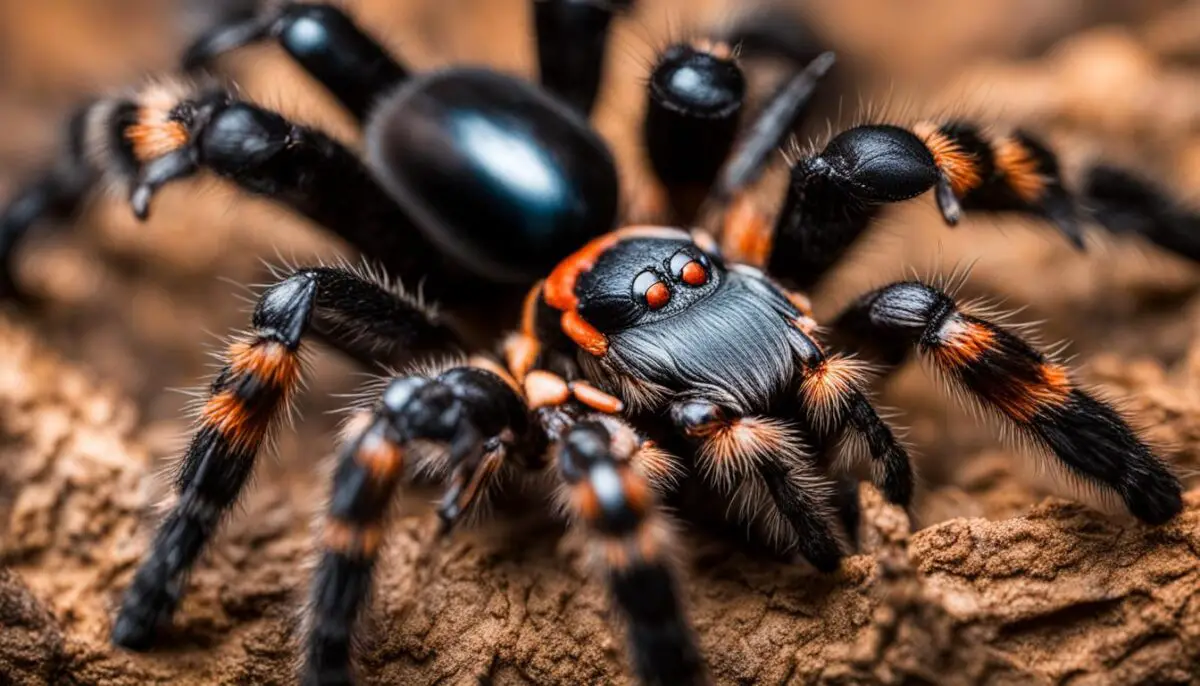When it comes to tarantulas, there’s a common misconception that these hairy spiders are highly poisonous and pose a significant danger to humans. In reality, tarantula toxicity is a rare occurrence, and the majority of tarantula-related injuries result from their urticating hairs, rather than their venom. So, just how many tarantulas are actually poisonous? Let’s delve into the facts.
Key Takeaways
- Most tarantulas possess venom, but it is generally mild in potency and not considered highly toxic.
- Severe reactions from tarantula bites are extremely rare, and there have been no reported human deaths caused by a tarantula bite.
- Certain species of tarantulas may cause discomfort and local tissue necrosis, but these instances are still uncommon.
- Tarantulas are better known for their defense mechanism of releasing urticating hairs, which can cause intense inflammatory reactions and irritation.
- Understanding the behavior and habits of tarantulas can help mitigate any potential harm and foster a sense of appreciation for these fascinating creatures.
How Many Tarantulas are Poisonous?
Understanding Tarantula Venom and Toxicity
Tarantulas, with their intimidating appearance, often evoke fears of venomous bites. But how potent is their venom, and what are the effects on humans? Let’s explore the fascinating world of tarantula venom and its toxicity.
Tarantula venom is a complex mixture containing enzymes, nucleotides, polyamines, neurotransmitters, free amino acids, and hyaluronidase. Although the composition varies among species, the venom generally works synergistically to paralyze prey and cause pain, tissue necrosis, and muscle cramping. However, when it comes to humans, the toxicity of tarantula venom is relatively low. While it can result in pain, local tissue necrosis, and, in rare cases, severe muscle cramping, there have been no reported human deaths attributed to tarantula venom. how many tarantulas are poisonous
The venomous nature of tarantulas is often overshadowed by their more prominent defense mechanism: urticating hairs. These barbed hairs, when released, can cause intense inflammatory reactions and irritation in potential threats. In comparison, the effects of venomous bites on humans are relatively mild. Tarantulas should be admired for their unique and fascinating adaptations rather than feared for their venomous nature.
| Tarantula Venom Effects on Humans | Severity |
|---|---|
| Pain | Moderate to Severe |
| Local Tissue Necrosis | Possible |
| Muscle Cramping | Rare, Severe Cases |
Overall, tarantula venom, although present in all species, is generally not a major cause for concern when it comes to human interactions. Understanding the behavior and habits of tarantulas, as well as their venomous capabilities, allows us to appreciate these fascinating creatures without unnecessary fear.
https://www.youtube.com/watch?v=Iht00BnXMEI
The Role of Urticating Hairs in Tarantula Injuries
Tarantulas have developed a unique defense mechanism to protect themselves from potential threats. These creatures possess specialized hairs called urticating hairs, which they release when feeling threatened or agitated. These hairs act as a deterrent by causing irritation and inflammation in potential predators, including humans. The presence of urticating hairs is a key factor in tarantula-related injuries, often overshadowing the venomous nature of these creatures. poisonous tarantulas
The urticating hairs of tarantulas have barbs along their shafts, allowing them to penetrate the skin and even deeper tissues. When these hairs come into contact with the skin, they can cause intense itching, redness, and swelling. In more severe cases, the hairs can cause an allergic reaction, resulting in systemic symptoms such as difficulty breathing or wheezing. The eyes and respiratory system are particularly vulnerable to the effects of these hairs, leading to painful conjunctival injection and even airway obstruction. venomous tarantulas
It is crucial to note that severe tarantula-related injuries are more commonly associated with the effects of urticating hairs rather than venomous bites. While tarantula bites can cause local pain and tissue necrosis, the venom itself is relatively mild in potency and rarely leads to life-threatening complications. Therefore, when considering the potential risks of tarantulas, it is essential to understand and respect the role of urticating hairs in their defensive strategy.
The Role of Urticating Hairs in Tarantula Injuries
Table: Comparison of Venomous Effects and Urticating Hair Effects in Tarantula Injuries
| Aspect | Venomous Effects | Urticating Hair Effects |
|---|---|---|
| Severity | Mild to moderate | Moderate to severe |
| Local Symptoms | Pain, tissue necrosis | Intense itching, redness, swelling |
| Systemic Symptoms | Rare; mild muscle cramping | Potential respiratory distress, conjunctival injection |
| Frequency | Extremely rare | More commonly observed |

Tarantula Toxicity and Epidemiology
Despite their reputation, tarantula-related injuries are actually quite rare. In fact, there are only a small number of reported cases each year. According to the American Association of Poison Control Centers, there were 44 reports of tarantula-related injuries in 2018, and only 17 of those cases required evaluation at a healthcare facility.
It’s important to note that while tarantulas do possess venom, there have been no reported human deaths due to tarantula toxicity. Although certain species may cause discomfort and local tissue necrosis, severe reactions and fatalities are extremely rare. tarantulas with toxic venom
Most tarantula-related injuries occur in adults and are primarily associated with the popularity of keeping tarantulas as pets. While tarantulas do have venom, the risk of serious harm to humans is minimal. It’s always important to handle and interact with tarantulas cautiously and with respect, but there is no need to fear them as dangerous creatures.
| Tarantula-Related Injuries (2018) | Reports | Evaluation at Healthcare Facility |
|---|---|---|
| Total | 44 | 17 |
Tarantulas are fascinating creatures that play an important role in the ecosystem. Understanding their behavior, habits, and the true risks associated with them can help dispel misconceptions and promote a greater appreciation for these unique arachnids.
Tarantula Behavior and Habits
Tarantula Diet
Tarantulas are fascinating creatures known for their unique behavior and habits. These large spiders have a diverse diet that primarily consists of insects, but they can also prey on small mammals or baby birds. Their carnivorous nature makes them skilled nocturnal predators, capable of capturing their prey with precision and agility. dangerous tarantulas
In the table below, we summarize the various food sources that tarantulas consume:
| Food Sources | Description |
|---|---|
| Insects | Primary food source for tarantulas. They feed on a wide variety of insects, including beetles, grasshoppers, and crickets. |
| Small Mammals | On rare occasions, tarantulas may catch and consume small mammals like mice or shrews. |
| Baby Birds | When given the opportunity, tarantulas may prey on vulnerable baby birds in their nests. |
It’s important to note that tarantulas are slow and deliberate movers. They rely on their stealth and patience to capture their prey, rather than chasing after it. This behavior allows them to conserve energy and ensure a successful hunt.
Observing tarantulas in their natural habitat can provide valuable insights into their behavior and dietary preferences. It’s a reminder of the intricate balance that exists within the animal kingdom, where each species has its unique role to play.
Next, we’ll explore the natural threats and enemies that tarantulas face, shedding light on the challenges these fascinating creatures encounter in their environment.
Natural Threats and Enemies of Tarantulas
Tarantulas, despite their formidable size and appearance, have relatively few natural enemies in the wild. However, there are a few notable threats that pose a significant danger to these fascinating creatures.
One of the main adversaries of tarantulas is the parasitic pepsis wasp. These wasps have a unique hunting strategy. They paralyze tarantulas with their powerful sting and then lay their eggs on the immobilized spider’s body. When the eggs hatch, the wasp larvae feed on the still-living tarantula, ultimately leading to its demise. This fascinating and brutal life cycle demonstrates the delicate balance of nature’s intricate relationships.
“Parasitic pepsis wasps have a unique hunting strategy. They paralyze tarantulas with their sting and then lay their eggs on the immobilized spider’s body.”
Tarantulas may also face threats from various predators such as birds, snakes, and other tarantulas. Certain bird species, like the roadrunner, are known to prey on tarantulas. Snakes, especially rattlesnakes, are also known to hunt and consume tarantulas, as they provide a substantial food source. Additionally, larger and more aggressive tarantulas can pose a threat to smaller species of tarantulas.
Another notable predator of tarantulas is the tarantula hawk, a type of solitary wasp. The female tarantula hawk captures tarantulas and paralyzes them with her sting. She then lays her eggs on the still-living spider, which serves as a food source for the wasp larvae once they hatch. The sting of a tarantula hawk is incredibly painful and is considered one of the most intense insect stings in the world.
Common Threats and Predators of Tarantulas:
| Predator | Threat Level |
|---|---|
| Pepsis wasps | High |
| Birds | Moderate |
| Snakes | Moderate |
| Tarantulas | Moderate |
| Tarantula hawks | High |
While tarantulas have defense mechanisms, such as biting and releasing urticating hairs, to ward off potential threats, they generally pose no serious danger to humans. These magnificent arachnids play a vital role in maintaining the balance of the ecosystem and should be respected as fascinating creatures rather than feared for their perceived danger.

Tarantula Reproduction and Behavior
Tarantulas have fascinating mating rituals and unique reproductive behaviors. Understanding their mating habits provides valuable insights into the life cycle of these intriguing arachnids.
Male tarantulas engage in a complex courtship display to attract females. They spin a web known as a sperm web and deposit their sperm on its surface. The male then uses his pedipalps, short appendages near the mouth, to transfer the sperm to the female during copulation. After mating, the male typically scuttles away quickly, as females sometimes exhibit cannibalistic behavior and may consume their mates. toxic tarantula species
Female tarantulas guard their eggs in a cocoon, protecting them from potential predators. The eggs develop for six to nine weeks before hatching, and hundreds of tiny tarantulas emerge. It’s a remarkable sight to witness the birth of these spiderlings and observe the early stages of their growth. Female tarantulas can live up to 20-25 years, while males have a shorter lifespan of 7-8 years. tarantula venom potency
| Species | Female Lifespan | Male Lifespan |
|---|---|---|
| Rose Hair Tarantula | 15-20 years | 4-6 years |
| Green Bottle Blue Tarantula | 10-15 years | 3-5 years |
| Goliath Birdeater Tarantula | 20-25 years | 5-7 years |
Observing tarantula reproduction can be an educational and awe-inspiring experience, providing a glimpse into the intricate behaviors and lifecycles of these remarkable creatures.

Notable Tarantula Reproductive Behaviors
- Male tarantulas perform elaborate courtship displays to attract females.
- Females sometimes exhibit cannibalistic behavior and may consume their mates after mating.
- Female tarantulas guard their eggs in a protective cocoon until they hatch.
- Tarantula lifespans vary by species, with females typically living longer than males.
Tarantula Bites and Injuries
Tarantula bites can result in various symptoms and effects, although they are generally not life-threatening to humans. The severity of the symptoms can vary depending on the species of tarantula and the individual’s sensitivity to the venom. Common local symptoms include pruritus (itching), swelling, and mild to severe pain at the site of the bite. However, it’s important to note that not all tarantula bites cause pain, and symptoms may be delayed for several hours or even days. poisonous spiders
Some tarantula species have venom that can cause local tissue reactions and necrosis over time. This means that the area around the bite may become inflamed, with the possibility of tissue damage and skin necrosis. It’s crucial to seek medical attention if there are signs of severe local reactions, such as extensive swelling, persistent pain, or the development of blackened or necrotic tissue. tarantula bite effects
In addition to venomous bites, tarantulas can also release urticating hairs as a defense mechanism. These tiny hairs have barbs that can cause irritation when they come into contact with the skin or mucous membranes. Exposure to urticating hairs can lead to moderate to severe pain, pruritus, and erythema (redness). If inhaled, these hairs can cause respiratory symptoms like cough, wheezing, and difficulty breathing. If the hairs get into the eyes, they can cause painful conjunctival injection, leading to potential long-term complications.

Summary
- Tarantula bites can cause local symptoms such as pruritus, swelling, and mild to severe pain.
- The severity of symptoms may vary depending on the species and individual sensitivity to venom.
- Some tarantula species have venom that can cause local tissue reactions and necrosis over time.
- Exposure to urticating hairs can result in moderate to severe pain, pruritus, and erythema.
- Tarantula bites and exposure to urticating hairs can have respiratory and ocular effects.
- Seek medical attention if severe local reactions, extensive swelling, or tissue necrosis occur.
While tarantula bites and injuries can cause discomfort and local reactions, they are generally not a cause for major concern. Understanding the potential effects and seeking appropriate medical care can help manage any symptoms and ensure proper treatment if necessary. It’s important to remember that tarantulas are fascinating creatures that are more known for their unique behavior and defensive mechanisms rather than their dangerous bites.
Conclusion
Tarantulas may be fascinating creatures, but they are often misunderstood and feared due to their venomous reputation. However, it is important to note that the majority of tarantula-related injuries are actually caused by their urticating hairs rather than their venomous bites. While tarantulas do possess venom, it is generally mild in potency and rarely causes severe reactions in humans. In fact, there have been no reported human deaths due to a tarantula bite.
With over 900 species of tarantulas found worldwide, it is crucial to understand their behavior, habits, and potential risks associated with them. Although some species may cause discomfort and local tissue necrosis, severe complications from tarantula bites are extremely rare. Tarantulas should be respected as fascinating creatures rather than feared for their perceived danger.
So, while it is true that tarantulas are venomous spiders, it is also important to remember that they pose little threat to humans. By gaining knowledge about these creatures and respecting their natural habitat, we can coexist with tarantulas and appreciate them for the incredible creatures they are.
FAQ
Are all tarantulas poisonous?
While all tarantulas possess venom, the venom is generally mild in potency. Severe reactions from tarantula bites are extremely rare, and there have been no reported human deaths due to a tarantula bite.
What are the effects of a tarantula bite?
Tarantula bites can cause local symptoms such as pruritus, swelling, and mild to severe pain. Depending on the species, local tissue reaction and necrosis can develop over time. However, severe complications are rare.
Do tarantulas pose a threat to human health?
Tarantulas generally pose little threat to humans. Understanding their behavior and potential risks can help mitigate any harm. Severe tarantula-related injuries are more commonly associated with urticating hairs rather than with venomous bites.
How many species of tarantulas are there?
There are over 900 species of tarantulas found worldwide. They can be found in tropical and subtropical regions across the globe.
What do tarantulas eat?
Tarantulas are carnivorous, with their diet primarily consisting of insects. However, they can also prey on small mammals or baby birds.
Do tarantulas have natural enemies?
Tarantulas have few natural enemies, but parasitic pepsis wasps and tarantula hawks pose a significant threat. Other threats include birds, snakes, and other tarantulas.
How do tarantulas reproduce?
Male tarantulas engage in a mating ritual where they spin a web and deposit sperm on its surface. After mating, the male typically scuttles away, as females sometimes eat their mates. Female tarantulas guard their eggs in a cocoon for six to nine weeks before hatching.
What are the risks associated with tarantula bites?
Tarantula bites can cause local symptoms such as pruritus, swelling, and mild to severe pain. Exposure to urticating hairs can result in moderate to severe pain, pruritus, and erythema. Inhaled hairs can cause respiratory symptoms like cough, dyspnea, and wheezing. However, severe complications are rare.
Should I be afraid of tarantulas?
Tarantulas should be respected as fascinating creatures rather than feared for their perceived danger. Understanding their behavior and potential risks can help alleviate any concerns.

